The 2nd ChatGPT4PCG Competition: Character-like Level Generation for Science Birds
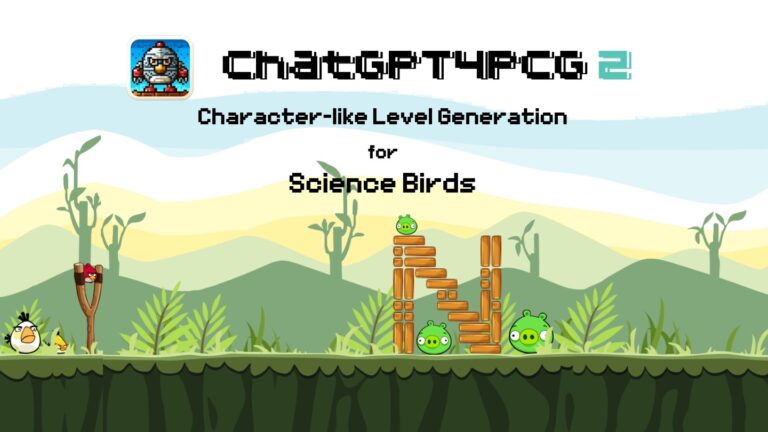
Short Description
The 2nd ChatGPT4PCG Competition continues the challenging and exciting spirit of the first competition. In this edition, we not only challenge participants to come up with a prompt to construct stable Science Birds levels resembling uppercase English characters, but we also open up the possibility of incorporating more complex prompt engineering techniques. This time, we allow the submission of a program in which participants can build on top of our examples and packages, enabling the use of conditions and iterations in programming to develop their own advanced prompt engineering techniques, and potentially create new ones!
We welcome participants of all levels, whether you only modify a prompt in a provided example or come up with a complex logic through prompt engineering. All programs will be inspected for qualification, subject to the competition rules, and used to generate levels for each target English uppercase character. The generated levels are then tested for stability using our Science Birds Evaluator and checked for similarity to respective target characters using an upgraded Vision Transformer (ViT) classifier. This edition also introduces a new metric–diversity, making it more challenging. Now, not only do the prompts and/or prompt engineering techniques developed by participants need to generate stable and similar levels, but they also need to generate diverse levels.
To participate, you must submit your prompt according to our guidelines. We will then generate a number of samples, each of which will undergo rigorous testing for stability, similarity, and diversity. Stability will be evaluated by loading the level in Science Birds and examining the ratio of unmoved blocks after 10 seconds of the initialization. The similarity of each generated level to its corresponding English character will be determined using an open-source ViT-based classifier model. The stability testing system and the instructions to use the classifier model, as well as all the relevant tools, will be provided. The newly introduced diversity is assessed by averaging the distances of unordered pairs of output vectors from the ViT classifier across trials, all pertaining to the same target character and prompt.
We hope that this edition will be more exciting and contribute to collective learning and discovery in the world of prompt engineering through this game competition!
Organizers
Pittawat Taveekitworachai, Graduate School of Information Science and Engineering, Ritsumeikan University
Febri Abdullah, Graduate School of Information Science and Engineering, Ritsumeikan University
Mury F. Dewantoro, Graduate School of Information Science and Engineering, Ritsumeikan University
Yi Xia, Graduate School of Information Science and Engineering, Ritsumeikan University
Pratch Suntichaikul, Graduate School of Information Science and Engineering, Ritsumeikan University
Ruck Thawonmas, College of Information Science and Engineering, Ritsumeikan University
Julian Togelius, NYU Tandon School of Engineering, New York University
Jochen Renz, School of Computing, The Australian National University
For more information, visit the competition’s homepage.
Tales of Tribute AI Competition
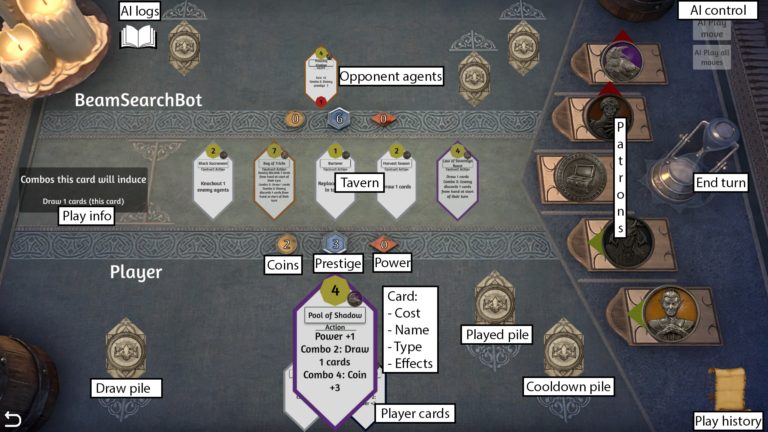
Short Description
The deckbuilding card game Tales of Tribute is a special activity added to the massively popular multiplayer online role-playing video game The Elder Scrolls Online. Although the game remains small by CCG standards (about 200 cards and only a few keywords), it is interesting and challenging for humans, with a significant potential for being a good AI testbed.
The players start with the same base cards and build their decks during the game by buying cards from a shared resource pool called the Tavern (a concept similar to Dominion). Tales of Tributes encourages strategic long-term planning – to ensure the deck we build contains enough strong cards and is not clustered with weak ones. Because of a huge randomness factor influencing, e.g., which cards occur in the Tavern, it is hard for the agents to stick with a pre-made plan successfully. So the game also requires considerable adaptiveness. Tales of Tribute AI Competition aims to fill the void after the Hearthstone AI Competition while being significantly more challenging than a toy problem covered by Legends of Code and Magic and the Strategy Card Game AI Competition.
The competition will be run using ScriptsOfTribute, an open reimplementation of the original game in the .Net framework designed especially for this event. It features the game manager that allows running AI agents implemented as C# classes (adapters for other languages are possible) against each other and a graphical user interface that support human vs. AI games.
The competition’s winners will be decided upon the global winrate in all vs. all tournament, conducted on a large number of mirror matches using the same seeds
Organizers
For more information, visit the competition’s homepage.
Dice Adventure Human-AI Teaming Competition
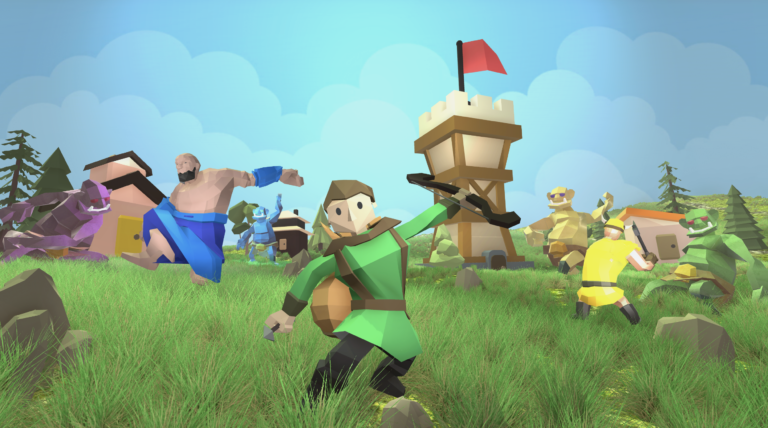
Short Description
Dice Adventure is a multi-player, turn-based, dungeon crawling adventure game developed at Carnegie Mellon University. This is the first time for us to host the Dice Adventure Human-AI teaming competition.
There are two tracks of the competition
1) participants can submit their agents to the agent track;
2) participants can play with other players and submitted agents in the player track. Agents submitted to the agent track will be randomly matched with players in the player track and be evaluated on the team score they achieved after running multiple levels of games. Winners will be declared based on overall teaming performance. We hope to bring exciting experiences to the participants as well as exploring critical human-AI teaming questions and gain a better understanding in team communication, coordination and adaptation.
Organizers
Qiao Zhang, Georgia Institute of Technology
Christopher J. MacLellan, Georgia Institute of Technology
Erik Harpstead, Carnegie Mellon University
Glen Smith, Georgia Institute of Technology
Adit Gupta, Drexel University
For more information, visit the competition’s homepage.
7th MicroRTS AI Competition

Short Description
Several AI competitions organized around RTS games have been organized in the past (such as the ORTS competitions, and the StarCraft AI competitions: AIIDE, CIG, SSCAI), which has spurred a new wave of research into RTS AI. However, as it has been reported numerous times, developing bots for RTS games such as StarCraft involves a very large amount of engineering, which often relegates the research aspects of the competition to a second plane. The microRTS competition has been created to motivate research in the basic research questions underlying the development of AI for RTS games while minimizing the amount of engineering required to participate. Also, a key difference with respect to the StarCraft competition is that the AIs have access to a “forward model” (i.e., a simulator), with which they can simulate the effect of actions or plans, thus allowing for planning and game-tree search techniques to be developed easily. Although we acknowledge that planning in domains for which the agent does not have a forward model is a very important problem, this is left out of this competition, in order to focus on other core RTS problems.
Organizers
Rubens O. Morales, Universidade Federalde Viçosa, Brazil
Levi Lelis, University of Alberta, Canada
For more information, visit the competition’s homepage.
2024 DareFightingICE AI Competition
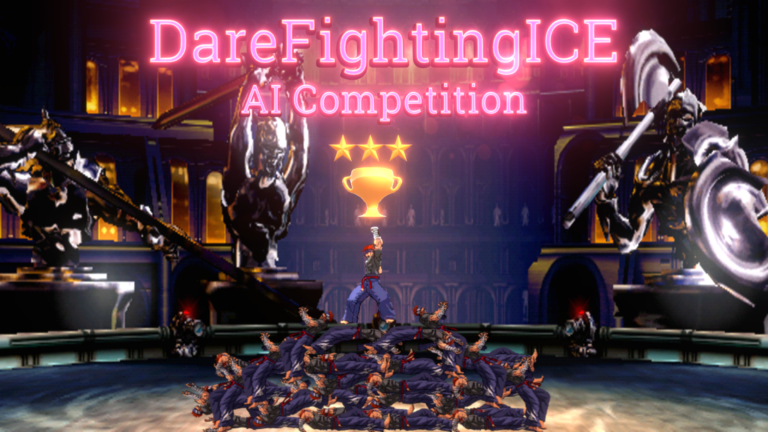
Short Description
In this competition, you are tasked with making an AI that plays DareFightingICE using only in-game sound data as the input. DareFightingICE is FightingICE with an enhanced sound design; the FightingICE platform itself was successfully used in a fighting game AI competition launched in 2013 and from 2014 to 2021 as an official competition at IEEE CIG/CoG. You will be provided with a gRPC interface that allows access to sound data and a sample AI.
Organizers
Van Thai Nguyen, Graduate School of Information Science and Engineering, Ritsumeikan University
Ibrahim Khan, Graduate School of Information Science and Engineering, Ritsumeikan University
Chollakorn Nimpattanavong, Graduate School of Information Science and Engineering, Ritsumeikan University
Kantinan Plupattanakit, Graduate School of Information Science and Engineering, Ritsumeikan University
Boyu Chuang, Graduate School of Information Science and Engineering, Ritsumeikan University
Ruck Thawonmas, College of Information Science and Engineering, Ritsumeikan University
For more information, visit the competition’s homepage.
2024 DareFightingICE Sound-Design Competition
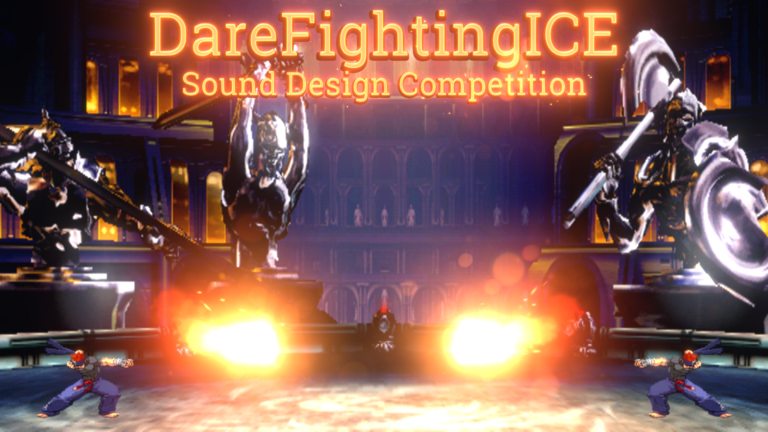
Short Description
In this competition, you have to make a sound design for DareFightingICE. Here, we define a sound design as a set of sound effects combined with the source code that implements their timing-control algorithm. Keep in mind that DareFightingICE is targeting visually impaired players, so the sound design you come up with should be made for visually impaired players. You will be provided with a sample sound design and all the sound effects used in the sample.
Organizers
Ibrahim Khan, Graduate School of Information Science and Engineering, Ritsumeikan University
Chollakorn Nimpattanavong, Graduate School of Information Science and Engineering, Ritsumeikan University
Van Thai Nguyen, Graduate School of Information Science and Engineering, Ritsumeikan University
Kantinan Plupattanakit, Graduate School of Information Science and Engineering, Ritsumeikan University
Boyu Chuang, Graduate School of Information Science and Engineering, Ritsumeikan University
Ruck Thawonmas, College of Information Science and Engineering, Ritsumeikan University
For more information, visit the competition’s homepage.
VGC AI Competition
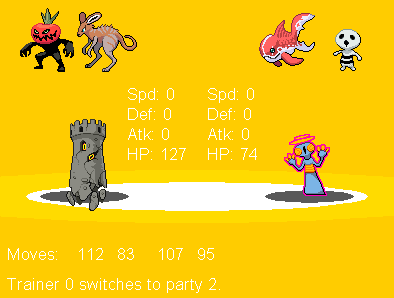
Short Description
Test the strength of your AI agents in Pokémon-like battles and a team building where you must anticipate the strategies of your opponents.
Organizers
Simão Reis, (LIACC/FEUP) Artificial Intelligence and Computer Science Laboratory, University of Porto
Rita Novais, (LIACC/FEUP) Artificial Intelligence and Computer Science Laboratory, University of Porto
Eliana Silva, (LIACC/FEUP) Artificial Intelligence and Computer Science Laboratory, University of Porto
For more information, visit the competition’s homepage.
2024 GDMC AI Settlement Generation Competition in Minecraft
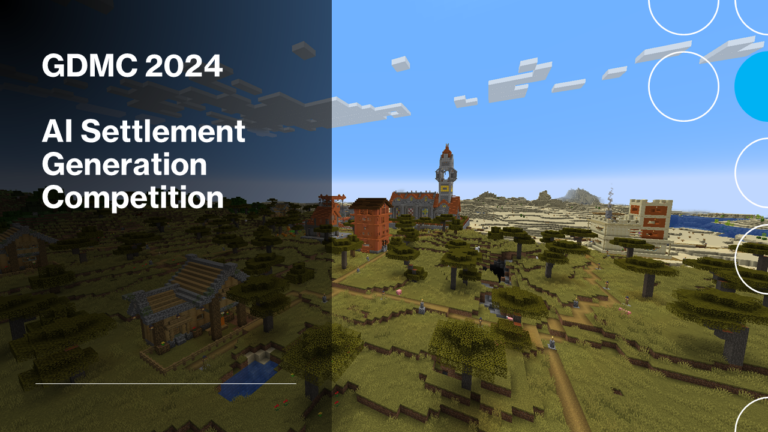
Short Description
The GDMC competition is about writing an algorithm that can produce an “interesting’’ settlement for a previously unseen Minecraft map. It was designed to provide an AI competition focussed on computational creativity, co-creativity and adaptive, as well as holistic PCG. Competitors submit their algorithm, in one of two formats (both available via GitHub, see webpage), and the organizers then apply the algorithm to three, previously unseen Minecraft maps. The resulting maps and settlements are then sent out to a panel of expert and public judges, who score each algorithm in four categories: adaptivity, functionality, evocative narrative and aesthetics.
Organizers
Christoph Salge, University of Hertfordshire, UK
Michael Cerny Green, NYU, US
Rodrigo Canaan, Cal Poly State University, US
Christian Guckelsberger, Aalto University, Finland & QMUL, UK
Victoire Hervé, University of Hertfordshire, UK
Julian Togelius, NYU, UK